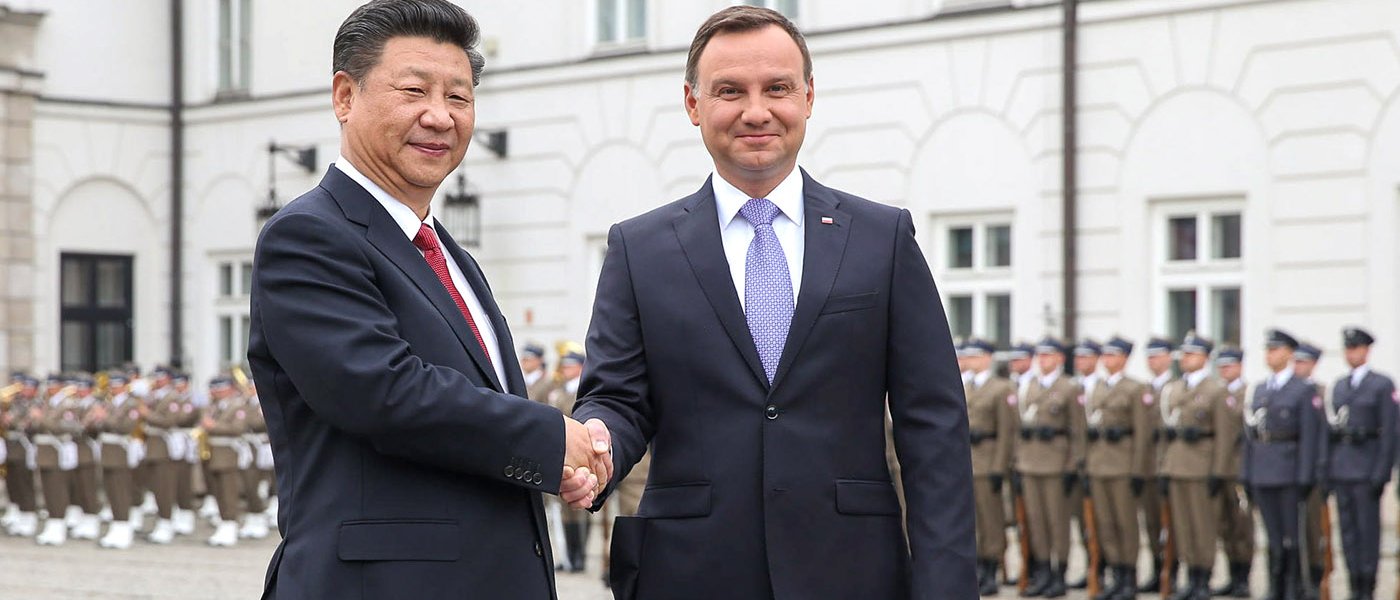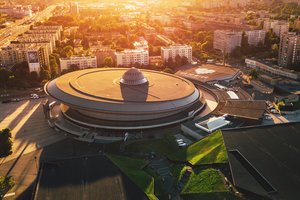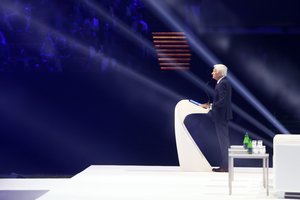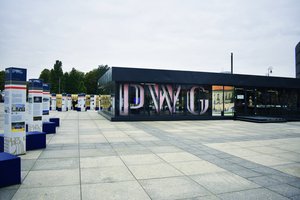The New Silk Road
This project, which refers to the ancient trade route, intends to be a building block for Poland’s national brand, presenting Poland as a friendly country with high ambitions and huge opportunities. “Rzeczpospolita” has assumed the media patronage of this ambitious initiative.
This project, which refers to the ancient trade route, intends to be a building block for Poland’s national brand, presenting Poland as a friendly country with high ambitions and huge opportunities. “Rzeczpospolita” has assumed the media patronage of this ambitious initiative.
It simply couldn’t have been any other way. The legendary Silk Road has always tempted me with its secrets, triggered my imagination with its caravans of camels, unfamiliar lands, and romantic and adventurous images. As it turns out, the mental images fathomed during the reading of travel books did not let themselves be forgotten.
The ancient trade route, with its extensive network, attracted merchants as early as the third century B.C. Merchants travelled half-way across the world, transporting back and forth exotic goods that smelled of distant countries. Spices, china, linen, amber, jewellery, paper, and luxurious silk, of course. The difficult road from China to the Roman Empire, filled with many adventures, was extremely dangerous. Mainly due to attacks by nomads, military conflicts, or bands of robbers that roamed the huge vast spaces of little-known lands, in the mountains, in the deserts, and endless steppes. The merchants also had to deal with local red tape, customs taxes, fees for ensuring security, or obtaining the necessary travel documents.
It took several years to travel the entire route, but it was well worth the effort. However, the merchants rarely travelled the entire route from start to finish. Usually, the goods were handed over, like a relay baton, to other guilds. As a result, the Europeans, who admired the beauty of silk, for many centuries did not have direct contact with the Chinese.
Major cities had huge markets, with stores offering fabrics, banks, translation offices, currency exchanges, or “tax offices” collecting taxes. You could find pack animals, guides, veterinarians, or security personnel there. In around 100 BC, Pilinius wrote that the Middle Kingdom, which was charmed by the west and its fairy-tale-like Daqin, that is Rome, sent a dozen or so caravans per year, which were mostly composed of reliable camels, but also of donkeys and mules, and the trading taxes accounted for 30% of the revenues of the Han dynasty.
The indefatigable merchants were accompanied by ideas and technological innovations on their way to the West and East. They connected civilizations, contributing to the spreading of cultures, beliefs, migration waves and led to the mixing of various ethnicities. Due to trajectory of the route, a lot of the trade activity helped bolster the development of many cities.
The new trade route had a similar impact on societies living thousands of kilometres from each other and, in doing so, created imported globalisation milestones during that era.
It is worth mentioning that these regions were crossed not only by merchants, but also by pilgrims, messengers, imperial officials, simple adventurers and papal emissaries. Benedykt Polak, a Grey Friar from Wrocław, whose footsteps I followed in the past when writing a book about him, went on a mission in the thirteenth century to see the Great Khan of Mongols.
Only some time later did the Venetian merchant and traveller, Marco Polo, whose description of the journey is one of the greatest historic testimonies of the Silk Road, follow in his footsteps. The golden era of the Silk Road was during the rule of the Tang dynasty (7-10th century), though the route experienced different periods of prosperity and worse times for trading, due to disturbances and the collapse of regional empires. It is important to note that late in the Middle Ages, the Silk Road also had its European branches – it connected the Mediterranean Sea and the Black Sea with the Baltic Sea and the North Sea, and ran through Kraków, Wrocław, Biskupin, Malbork, and Gdańsk.
During the rule of the Qing dynasty, the shipbuilding industry quickly developed, and sea transport turned out to be safer, much faster – and much cheaper. One ship could take the load that used to be carried by a caravan consisting of a thousand of pack animals. In the sixteenth century, the Ottomans conquered the Byzantine Empire, destroyed the merchants’ villages, and disrupted the traditional walking routes. What is more, China, under the influence of the Mongolian peoples, closed themselves off behind the fortifications of the Great Wall. All this contributed to the demise of the land route, though some of its local sections continued to operate for a longer period of time.
In the footsteps of Marco Polo
The most famous ancient trade route was featured in my shows since the beginning of my travelling career. The lure of the off-beaten routes and curiosity in the old world took its toll. I quickly learned that the passing time badly affected the remaining ruins of the ages past. Most of the temples, garrison cities, Buddhist stupas – they were all engulfed by the desert or failed to survive wars, plundering, or negligence. The old caravan paths were replaced with asphalt roads and railway tracks, and the Bactrian camels – with heavy trucks bearing GPS devices. Luckily, many traces from that era still exist, and we can immerse ourselves in them today. The ancient ruins that have survived to this day still have their charm and are testimony to the magnitude of the old cultures.
I have experienced countless aesthetic sensations in Xi’an, a city that now has 8 million residents, which used to be the capital of an empire, one this is often truly revered by the Chinese. In terms of affluence and style, this city was like no other. It was the biggest and the most culturally diverse conglomerate of the world, attracting business people, merchants, craftsmen, courtesans, and holy men from all over Asia. This is the place from which the caravans set out on their long journey towards the basin of the Mediterranean Sea. It was there that the world-famous terracotta army, created 200 years BC, encouraged me to reflect on the world around us.
Sometimes I veered off the road to walk the paths of forgotten regions, only to reach blooming Uzbekistan, restored to its former glory, the essence of the Silk Road at its section in central Asia. In Samarkand, the conqueror and ruthless tyrant Timur, also called Tamerlan, built one of the most spectacular examples of Islamic architecture from the Mongolian dynasty era. After restoration, one of the oldest cities in the world once again regained its lavishness and splendour. The mosques, decorated with colourful maiolica tiles, give the city its unique charm. If these incredible buildings became the focus of attention of the global tourism industry, they would surely be trampled by hordes of visitors, as it is the case in Angkor, Petra, or Machu Picchu.
I was also enchanted by the story of Bukhara, with its madrasas, turquoise arabesque designs, and exquisite domes of the mosques. In nearby Kyrgyzstan, I delved into the country’s history, visiting a very well preserved stone canvaserai, Tash Rabat, situated in a picturesque mountain valley. Many such inns, which used to be a place of respite for the travellers of yesteryear, have now been converted into hotels or restaurants.
Also in Kyrgyzstan, 20 years ago, among the wild mountain passes and incredibly tall peaks of the roof of the world, I encountered the commercial spirit of the Silk Road of our times. After the collapse of the Soviet Union and the unexpected regaining of independence by the countries of the region, Osh experienced an incredible boom. Several dozen years before that, the tensions between China and Russia led to the closing of borders, which killed trade, pushing the city into poverty. Now, the oldest market in Central Asia, was being restored to its former glory. The Karakoram Highway, running from Osh to the Chinese city of Kashgar, the largest trading city of the Silk Road, is again filled with caravans –now in the form of an endless column of huge trucks. The local market charms everyone. It is a true labyrinth of thousands of stands offering toiletries, rice, fruit, fake Adidas and Nike shoes, pirated DVDs and home appliances made in China.
The cross-border trade led to the birth of new markets, yards, including an impressive wholesale centre in Karasuu on the border between Uzbekistan and Kyrgyzstan, where the annual turnover exceeds USD 9 billion. In my imagination, I could see these markets as Marco Polo saw them. Goods are transported like in the good old times: carts pulled by donkeys, men carrying huge bags on their backs, heavy heaps of goods pulled by carts, and also bikes filled with goods, honking cabs, as well as Russian Kamazs, emitting black fumes. A noisy, grey stream of people, contrasting with the bright colours of the women’s dresses and shawls: wholesalers, merchants and individual buyers.
People from Uzbekistan mix and mingle with people from Tajikistan, the Kirghiz with the Russians and the Chinese. Uyghurs are a completely different group. They are a mix of Persian and Turkish peoples, who converted to Islam in the fifteenth century, and today, torn between China and Mahomet, live in the obscure region of East Turkestan, currently Xinjiang Uyghur Autonomous Region. Much like the Buddhist monks, who came to India with a mission to convert the locals and brought their religion with them, which was later replaced by the Islamic civilization, in our times eager missionaries, in the form of volunteers teaching English, try to spread the Christian faith in secret.
Arena of the grand game
Xinjiang was the arena of a grand game of the Silk Road, which had already been forgotten by the nineteenth century. The issue in question here is the ardent and secret rivalry between the British Empire and Tsarist Russia for military and economic supremacy in Central Asia. What followed was a hundred years of missions, concocted plans, and daring fights for influence in the regions lacking clearly set borders; a secret undeclared war, collecting intelligence and establishing alliances with affluent khans in order to create a buffer zone between the armies of the opponent.
Networks of paid informants spied for the players of this game. These included outstanding Polish explorers providing information to the Tsar (for example Jan Prosper Witkiewicz, Leon Barszczewski, or general Bronisław Grąbczewski), about diplomatic intrigues, the presence of foreign agents, and anything regarded to be a valuable snippet for military purposes, that is social attitudes, the condition of roads, the movements of armies near the border, or the construction of iron rails. The grand game was, in reality, won by Russia: the khanates collapsed, becoming Russia’s lieges, and the new Soviet Union artificially created five republics that were dependant on Moscow, forcing peaceful co-existence on them. The modern post-Soviet borders did not ensure the unity of nations, not to mention their independence.
In the 1990s, a new, grim chapter in the grand game began. Central Asia once again became the arena of a quiet and paced-out race for power, this time between Russia and China. No wonder, because the territory that amounts to almost half of Europe’s territory, hides huge deposits of minerals, not to mention its strategic location in the centre of Eurasia, and its natural fortifications, which are the key to ruling the entire continent. Genghis Khan, the founder of the Mongolian Empire, took control over of the silk routes network after conquering the region. In the countries where the knowledge of the Russian language is common, it is Russia that has the most political influence, but the Middle Kingdom, which is becoming more and more of a power on the continent, is dominating economically.
Thanks to the Royal Geographical Society in London, I crossed the Taklamalak Desert – the most difficult obstacle along the Silk Road – on the back of a Bactrian camel. This desert, one of the largest in the world, has always been a source of terror for travellers. Rumour has it that, wanting to help the residents of these lands, the Creator divided the most priceless things among them. He gave Kazakhs a golden axe, so that they could crush the Altai Mountains and allow water to flow down to the lowlands so that it can nourish the fields. Uyghurs were to be given a golden key to a treasure of jewels located in the valley of the Tarim river. Unfortunately, a daughter of an Uyghur khan lost the key. The god got so angry that he trapped the girl between the banks of a river, which was the beginning of the Taklamakan desert. The place, whose history has such awful roots, cannot have a pleasant name. In the native language, its name means “enter, and you won’t leave”. Crossing it resembled playing with death. Nobody knows how many caravans stayed among its sands forever.
The truly fascinating stories about archaeologists and their sensational discoveries also helped me to re-discover that era. At the beginning of the twentieth century, while searching for treasures left behind by former civilizations in the oases engulfed by the sands of Taklamakan, Sir Marc Aurel Stein discovered a treasure-hove of Buddhist art in the caves of Mogao. Sir Marc would take back with him a dozen or so chests filled with priceless finds. He was followed by local thieves, European treasure hunters, and archaeologists - adventurers, who stole the rest.
What remains of the Silk Road was awarded an elite distinction in 2014. UNESCO recorded the surviving treasures on its national heritage list, so that they are protected against damage and so that they can survive for future generations. There are 33 rare tourist attractions on the 5,000 km long route from Chang’an (today’s Xi’an) to Tian Shan, leading through China, Kyrgyzstan, and Kazakhstan palace complexes from different empires, ancient trading posts, fortifications, Buddhist temples, navigation towers, and parts of the Great Wall.
One Belt, One Road
The economic potential of the former land route encouraged China to reconstruct the New Silk Road. Three years ago, Xi Jinping, the Chinese president, presented his ambitious vision of global trading roads and the global economy befitting the new era. The breakthrough initiative entitled “One Belt, One Road” creates the backbone of Beijing’s foreign and internal polic.y Its aim is to establish land-sea transportation routes that connect the Middle Kingdom and the countries of Central Asia with the Old Continent. Experts say that there has never been such an ambitious undertaking in the economic history of the world.
Poland joined this historic project and intends to play an active part in it. Local economists perceive it as an opportunity to accelerate our economic growth. For Chinese strategists, Poland, due to its geographical location, is a key country on the renewed cross-Asian road. Poland could be a gate to Western Europe.
It is good that the President Andrzej Duda declared his willingness to participate in building the Silk Road. This fact might improve political and business relations, which could be better, as the endeavour is important from the perspective of economic diplomacy, which should support small and medium enterprises. Media play a huge role in it, and here lies the rub. When the President Bronisław Komorowski signed a strategic partnership agreement in Tokyo, Polish journalists failed to mention the results of the visit; instead, they focused on the ‘scandalous’ faux pas – stepping on the chair of the Parliament’s speaker. The diplomatic success of Andrzej Duda during the Chinese 16+1 summit at Suzhou has also not been discussed in enough detail, even if the Polish leader was accepted in the same way as Angela Merkel. It was no better during the visit of Xi Jinping to Warsaw, which was closely followed by the media, when his speech during the international forum was interrupted by the state TVP Info station to show a press conference of the national football team.
We have a good hand and we could use these cards to play the role of a European terminal. However, there are some problems regarding transit through Russia. To avoid squandering this huge opportunity, we have to do something about our eastern neighbour. An idea was proposed by the President of Kazakhstan, Nursultan Nazarbayev, who said during a meeting with Andrzej Duda: ‘Transportation is the biggest challence. How can we travel from Poland to Kazakhstan and back? The traditional transportation corridor is through Russia. Mr President, let’s talk to Russia, together. Let’s start working on a trilateral agreement, at least one that could concern transportation’.
I believe that the problem extends beyond Poland and its economic interests. It is of a wider EU character, and as such, it should be tabled by Poland and perhaps by other Visegrad Group countries to Brussels. Russia cannot be perceived solely as a potential enemy, it must also be a partner that helps resolve important economic problems. By proposing negotiations, we are giving Russia a chance.
The “One Belt, One Road” project has rekindled the long-forgotten fascination of the ancient treaty and was the beginning of the idea of organising a “New Silk Road 2017” journey. I thought that, like in the olden days, great civilizations shared their technical achievements and knowledge, met, and their cultural influences mixed came together and wove together their cultural experiences. That is why, today) its cultural heritage might serve as the grounds for building extensive cooperation. In the global context, the old route is becoming a symbol of high trading and the cultural potential of the entire region.
It is a huge challenge that requires meticulous planning and thorough organisation. The journey (www.silkroad-2017.com), which is supported by Foreign Minister Witold Waszczykowski and various sponsors, will travel along a route from Beijing to Warsaw in a column of cars. Its main objective is to boost Poland’s national brand, to promote a friendly country, which offers a lot of opportunities and has great people, showcasing a country that has high ambitions and wishes to conquer the world.
This trip is intended to show how beautiful Poland is and to promote our country as a gate to Europe, in order to strengthen economic relations between Poland and China. All this in the spirit of adjustments to the future and to the new world order. Also of significance is rekindling the roots of the Polish diaspora, strengthening its identity and identification with its homeland. Moreover, the trip is also intended to spread the word about the historic Silk Road as the international heritage element and to promote its influence on culture and the development of civilisation. By doing so, strengthening efforts to protect cultural heritage and promote cultural exchange. “This is quite an important platform for international cooperation, which offers high diplomatic and media potential along the entire route,” says Marcin Jacoby of the Adam Mickiewicz Institute. “This opportunity should be exploited accordingly, so that it can become a flagship idea for the promotion of our country in 2017.”
JACEK PAŁKIEWICZ
 Source: Rzeczpospolita
Source: Rzeczpospolita
17.10.2016







